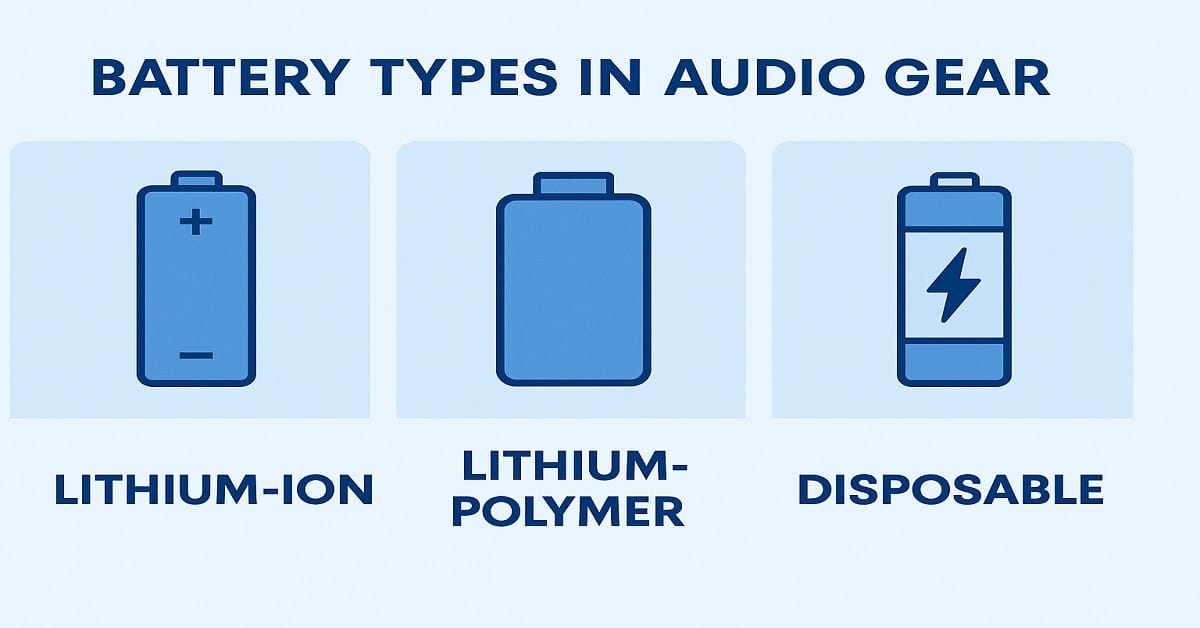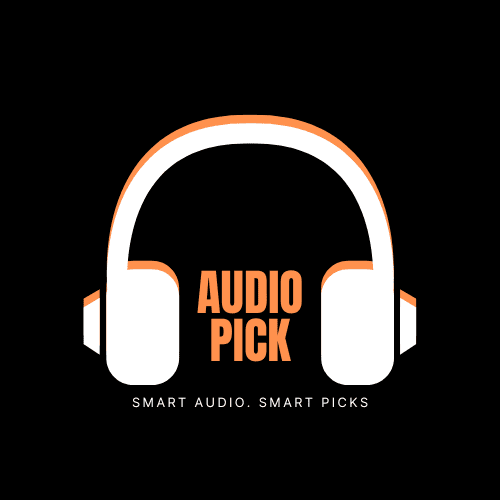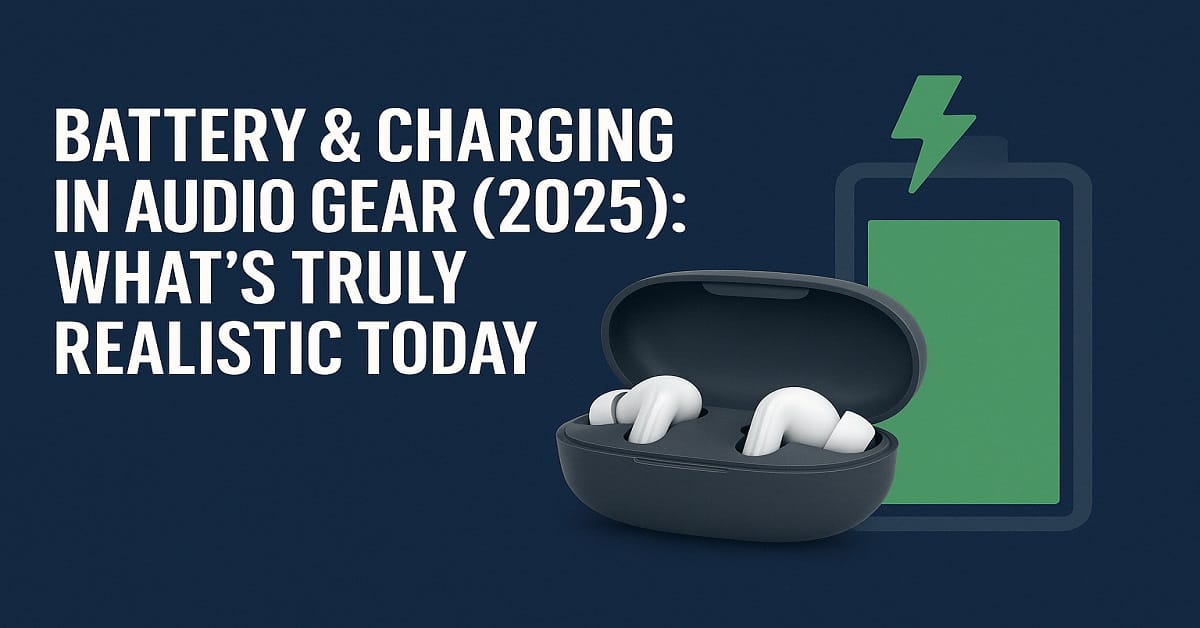You’ve likely typed something like “how many hours earbuds battery lasts” or “is 10-minute fast charge enough” into Google. That’s because battery life in audio gear is a constant worry.
- As a listener, you want your headphones or earbuds to last through flights, workdays, or workouts — without sudden power drops.
- But many specs feel too optimistic or vague, and real usage rarely matches what the brand claims.
- In this article, we’ll break down battery & charging audio gear — what’s realistic in 2025, the science behind it, types of charging, trade-offs, and tips for making the most of your device’s battery.
We’ll cover definitions, mechanisms, types/variations, pros & cons, real-world use cases, comparisons, FAQs, and practical advice. Let’s get into it.
Definition
What do we mean by “battery & charging in audio gear”?
It covers two connected parts: how long the battery lasts (playback time, standby, battery cycles) and how quickly you can recharge it. For headphones, earbuds, and portable speakers, “battery & charging” means:
- Playback life: hours of use before recharge.
- Charging speed / time: how long it takes to get a full charge (or partial).
- Battery cycles & degradation: how many times it can charge/discharge before capacity drops.
- Charging methods / technologies: wired, wireless, fast charging, trickle charging, etc.
To a beginner: think of battery life as your stamina, and charging speed as how fast you can recover your energy. Over time, stamina will fade (battery degrades).
How Battery & Charging Works in Audio Gear
Here is a simplified step-by-step explanation, with an analogy:
- Battery chemistry
Most audio gear uses lithium-ion (Li-ion) cells or lithium polymer (LiPo). Inside, lithium ions move between anode and cathode through an electrolyte when charging/discharging. - Power draw during playback
When music plays (or ANC is on), the device draws current from the battery. It powers digital circuits, DACs, amplifiers, Bluetooth radio, sensors, mic arrays, etc. - Voltage conversion & regulation
The battery delivers a certain voltage (e.g. 3.7 V nominal). The internal circuitry steps it up or down (using DC-DC converters) to power internal parts reliably. - Charge control
Charging is managed by a battery management system (BMS) or power management circuit. It monitors voltage, temperature, and current to ensure safe charging. Charging in two phases: constant current (CC) until a threshold, then constant voltage (CV) till full. - Fast charging vs standard
Devices support different charging standards (e.g. USB-C, QC, PD, proprietary). Fast charging pushes more current or voltage, but thermal limits and battery chemistry limit how fast you can push it safely. - Cycle & degradation
Every full charge and discharge is a “cycle.” Over many cycles, battery capacity drops. The BMS protects against overcharging, overdischarge, overheating, which also helps longevity.
Analogy:
Imagine you have a water tank (battery). You draw water (electricity) to run appliances (audio gear). To refill, you pump water in. If you try pumping too fast, leaks or damage might occur (battery stress). Over time, the tank walls weaken (battery degradation), so it holds less water.
Types / Variations in Battery & Charging Audio Gear

Audio gear comes in various battery & charging types. Knowing them helps set realistic expectations.
Standard Charging
Normal current (e.g. 0.5 A to 1 A) via USB or proprietary cable. Safe, gentle charging, less heat, slower.
Fast / Quick / Rapid Charging
Higher current or voltage (e.g. 2 A, 3 A, or use of USB Power Delivery) lets the device charge faster. Many modern earbuds/headphones support fast charging: e.g. 5 minutes = 1 hour playtime.
Wireless Charging & Reverse Wireless Charging
Some devices support Qi wireless charging (drop-on pad). In advanced cases, the charging case of earbuds can also charge a phone (reverse wireless). E.g., Anker’s Soundcore P41i case has 3,000 mAh and can partially charge a smartphone. The Verge+1
Multi-cell / High-capacity Cases
Charging cases often contain multiple battery cells, adding extra playtime. For earbuds, this is common: earbuds might last 6–10 hours alone, but case gives extra 30–50 hours. Soundcore’s Liberty 5, for example, offers 8 hours with ANC + an extra 40 hours via case. soundcore
Charging in Pieces / Incremental Charging
Some devices are optimized to quickly give you a bit of juice (fast partial charging) rather than always full charge. Useful for short top-ups.
Adaptive / Smart Charging
Devices learn your charging habits (overnight charging) and slow the charge near full to reduce stress. Some will pause or trickle charge to preserve battery health.
Advantages & Limitations
Advantages – Battery & Charging Audio Gear
- Convenience & portability
Good battery & fast charging means you carry less, plug less, and worry less on the go. - Better user experience
Fewer interruptions, less anxiety about “battery panic.” - Technology boosts
As batteries improve, devices can afford more computation (ANC, spatial audio) without killing battery life. - Power sharing possibilities
Charging cases that double as power banks are a plus — your earbuds can help charge your phone in emergencies (see P41i case). The Verge
Limitations & Real Trade-offs
- Heat & safety
Fast charging generates heat. If poorly controlled, it degrades battery and can be unsafe. - Battery degradation
Higher charge/discharge rates shorten battery life over months / years. - Diminishing returns
Pushing for extreme specs (e.g. 100 hours) may require trade-offs (brighter LEDs, larger battery, more weight). - Hardware limits
The size constraints in earbuds/headphones limit how big the battery can be. - Inefficiencies
Voltage conversion, idle circuits, radio use — all waste some energy.
Practical Scenarios & Use Cases in 2025

Let’s see how these battery & charging realities play out in real life:
- Daily commute / office use
A headphone with claimed “30 hours playtime” might give 24 in real use (ANC + Bluetooth). You want fast charging that gives you 1–2 hours of use with just 10–15 minutes plugged in. - Long travel / flights
If your earbuds can do 8 hours continuous, a case that adds 40–50 can help you cross continents without clutching a wall charger. - Gym / workout sessions
Short bursts of use, so fast top-up charging (5 minutes = 1 hour) is enough, battery life is secondary. - Weekend trips / camping
Here battery life and charging efficiency matter most; fewer stops, limited power sources. - Power sharing in emergencies
If your earbuds’ charging case can also charge your phone, that’s a clever multi-purpose tool (but the charge rate will be slow).
Comparison with Alternatives & Related Concepts
- Wired audio gear (over-ear wired headphones, wired IEMs)
They don’t rely on battery for playback, only for amplification (if any). But they lose portability and convenience. - Battery vs supercapacitors / new cell chemistries
Future batteries may shift to solid-state or hybrid solutions (lower heat, faster charging), but in 2025, Li-ion remains dominant. - Battery swap vs sealed battery design
Some devices (rare in audio gear) allow battery replacement — better long-term sustainability. Most modern earbuds don’t. - Power-saving features
Auto shut-off, low-power standby, efficient chips — these reduce energy draw and extend effective battery life.
Recommended for You
- What Does ENC Really Mean? A Deep, Honest Look at Environmental Noise Cancellation in Neckbands
- Are Noise-Cancelling Neckband Earbuds a Smart Investment in 2025?
- OnePlus Bullets Wireless Z2 Common Problems – Real Fixes You Can Actually Use
- Waterproof Neckbands Under 3000 – Real Picks You’ll Actually Love
- Magnetic Neckband Earphones India – What’s the Hype All About?
FAQs
Q1. What is a realistic battery life for earbuds/headphones in 2025?
For earbuds with ANC, 6–10 hours alone is realistic. Cases often add 30–60 hours more. For over-ear models, 25–40 hours is common.
Q2. How fast can charging be in 2025?
Expect 5–10 minutes to give 1–2 hours of use; full charging in 60–120 minutes depending on device size.
Q3. Does fast charging damage battery life?
Slightly, yes. Over time, pushing high currents degrades chemistry faster. Good battery management can mitigate this.
Q4. Can audio charging cables support higher wattage?
USB-C and modern standards support higher currents/voltages, but device design determines what it can take.
Q5. Why does my battery drop from 100% to 90% quickly?
Because real-world use (amplifier, radio, sensors) draws more power than ideal test scenarios.
Q6. Can battery life improve with firmware updates?
Yes. Some devices improve power usage efficiency through firmware tweaks, better power management.
Conclusion & Actionable Advice
To sum up: battery & charging audio gear in 2025 is improving, but realistic expectations matter. You won’t get all-day, always-on usage from tiny earbuds, but premium gear can carry you through travel, workdays, and more with smart charging.
Actionable advice for you, the listener / buyer:
- Don’t trust specs blindly — check real tests and user reviews.
- Prioritize fast top-up charging (5 min = usable time) over max hours.
- Look for smart charging / adaptive charging features to preserve battery.
- Use power-saving settings like auto-off, lower volume, disable features you don’t always need (like ANC or spatial audio).
- Protect your gear from heat — charge in cool environments for longevity.
Liked What You Read? Power Up Someone Else’s Knowledge!
If this article helped you understand what realistic battery and charging performance looks like in today’s audio gear, don’t keep it to yourself — share it! Whether your friends are music lovers, gadget geeks, or just tired of batteries dying too soon, this post can help them make smarter choices too. Every share helps more people learn the truth behind battery claims, avoid marketing hype, and get the best value for their money. So go ahead — hit that share button and spread the charge!

About the Author
Hari Prasad is the editor of AudioPick.in and a lifelong audio enthusiast. He writes detailed, honest reviews and guides to help everyday users pick the right gear without tech jargon. His personal interest in Bluetooth audio, neckbands, and codecs comes from testing dozens of devices over the past few years.

